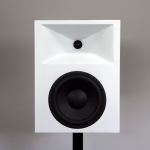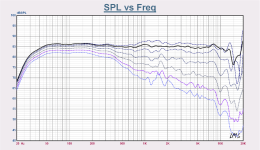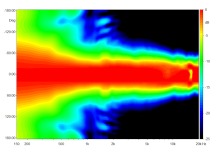Eg: https://www.diyaudio.com/community/threads/beyond-the-ariel.100392/post-7281403It all depends how the wave front looked like at the entry section of cells.
I have a number of horns with various aspect ratios that I've listened to. The switch in dominant V-H beamwidth (flip?) does not seem to affect the image (to me) because its the same from both R+L. It does effect the radiated power of the speaker and can cause timbre (spectral balance) problems because the radiated power is more frequency dependent.
[edit] I'm assuming listening in one position, if you move around too much the image will change on any speaker.
[edit] I'm assuming listening in one position, if you move around too much the image will change on any speaker.
Last edited:
Not all and any - a really proper omni directional speaker maintains the stage over a very wide area.
//
//
I have omni's as well, if you move around the image certainly changes. How can it not? Get closer to one speaker or nearer a wall and the image changes. The radiated power and spectal content are more consistent.
In a home audio context, I would too.I would be happy if someone could explain what exactly happened when saying "i have heard a pattern flip".
Given home audio is so single listening-position focussed, how would anyone even go about assessing it?
I think pattern-flip is a well known proaudio term for the way higher H:V aspect ratio horns cover audiences in live and install sound...
where a primary goal to achieve the same sound at as many seats as possible.
Then, either measuring or walking around seating spots that vary vertically, tonality shifts from pattern flip will appear.
But again, for home audio...probably no big deal imo.
I think people forget how crisp imaging can be. Higher DI is conducive to better imaging in a room than Lower DI. While an omnidirectional speaker, will maintain the image over a wider space, it will also be worse imaging.
Not specifically.Oh you mean this?
View attachment 1193109
The cardiod principle is all the rage these days, but the effectiveness decreases in a freestanding setup.
The first mini monitor shown in post #11,998 is particularly special because it deliberately dispenses with all kinds of tricks to suggest bass reproduction.
Of course the DD-8c and the Kii are extremely popular for (home) studio use, but the value for money is below par in my opinion.
Apart from the internal electronics, you still listen to a (admittedly good) dome tweeter flanked by woofers that cost 13 euros each (in case of the Kii).
The extremely expensive BXT modules embody a lot of marketing BS as far as I'm concerned, so it seems mainly a source of extra income.
For both the Kii and the DD-8c, the long-term operation mainly depends on the durability of the internal electronics.
In terms of price performance and max. output level, the GGNTKT M1 (€ 7,950.00 per pair vs €15,995.00 for the Kii) is the most attractive option imo.

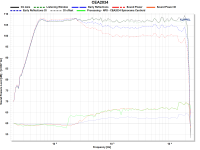
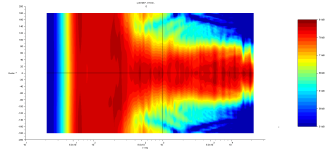
..because often enough a more narrow vertical opening is desired to achieve closer inter-driver distance (tweeter-midrange) to improve typical combing between the two drivers.Why creating the problem in the first place and then solve it with something else?
Nicer but less accurate. This from a "HiFi" perspective. Björk dont count - right? I dont crawl around the stage with my ear to 10cm form the a guitar.... do you? For me its like when you add way to much Sharpness in Photoshop - it looks bad / artificial.I think people forget how crisp imaging can be. Higher DI is conducive to better imaging in a room than Lower DI. While an omnidirectional speaker, will maintain the image over a wider space, it will also be worse imaging.
//
Last edited:
This, however, I would substituteThen, either measuring or walking around seating spots that vary vertically, tonality shifts from pattern flip will appear.
for:
Last edited:
Of course it changes. In the same way as if you go and stand beside or in front of a string quartet. But it doesn't fall apart completely. Thats the difference and hence more like IRL.I have omni's as well, if you move around the image certainly changes. How can it not? Get closer to one speaker or nearer a wall and the image changes. The radiated power and spectal content are more consistent.
I think not true. F.e. a studio engineer who works nearfield in a room that has been designed to have no first reflections, low DI does not really matter as long as he listen on axis. Of course if there are more people in the studio that are listening in, it matters, but he won't complain about less accuracy when sitting in the sweet spot with a high DI speaker. Acoustics play a much lesser role in this case. In a normal room though it probably will, but it can be fixed with room treatment -something that not everyone is willing to do. But your statement is not always true i.m.o.Nicer but less accurate.
A (multi mic:ing) studio engineer that work near field has noting to do with fidelity. Only with "nice". As I see it.
//
//
It also depends on the quality of the recording. If the recording is flat, panpotted, harsh and grainy, on a proper system it will also sound that way. In that case the playback system is not to blame but that happens a lot.This, however, I would substitute
Let's say the recording is like a steak.
There' are certainly excellent cuts of steak and certainly near dog-food cuts too.
I view omnis as a good steak sauce......that make even the bad steaks taste pretty good.
Unfortunately omnis take excellent steaks needing no sauce, down to the most common denominator level....
......IOW, hey, all the steaks taste the same, who cares about the cut of meat. 😛
Omnis can hide a lot of audio sin...... imnsho....LOL
There' are certainly excellent cuts of steak and certainly near dog-food cuts too.
I view omnis as a good steak sauce......that make even the bad steaks taste pretty good.
Unfortunately omnis take excellent steaks needing no sauce, down to the most common denominator level....
......IOW, hey, all the steaks taste the same, who cares about the cut of meat. 😛
Omnis can hide a lot of audio sin...... imnsho....LOL
As Ro808 points out in his pic, the ability to pinpoint instruments and singers in the mix is linked to dynamics. I wonder if that is the reason I like horns in general and more or less beamy horns (not too beamy of course) in particular. Clarity and naturalness does not solely depend on DI I guess. So many mysteries pfff... science and measurements and what more really is still not fully able to describe what is going on. Glad it don't.. 😉
Coming from a ignorant position, this description is woolly! I.e loose in the edges! In a room, diffraction/reflections from nearby objects, walls and so forth will change the tonality. You have to be more precise than this to post statements...For example, if you walk through the room while listening to music, which I do a lot, 'unnatural' shifts in the 'projected acoustic image' are clearly perceptible.
And once you have observed this phenomenon, it becomes easier and easier to detect it.
Of course there are all kinds of factors involved, such as the size of the horns and the H:V angle ratio - as Mark rightly pointed out.
There is a term for what you descri9be and its called the Directivity Index (DI) and its smoothness is critical to a speakers quality. Whether it should be higher or lower, I think that depends on what you are trying to do.It does effect the radiated power of the speaker and can cause timbre (spectral balance) problems because the radiated power is more frequency dependent.
Well put. You are learning well.I think people forget how crisp imaging can be. Higher DI is conducive to better imaging in a room than Lower DI. While an omnidirectional speaker, will maintain the image over a wider space, it will also be worse imaging.
The lower DI will also enhance spaciousness, which many may like. I look for great imaging and higher DI.
- Home
- Loudspeakers
- Multi-Way
- Is it possible to cover the whole spectrum, high SPL, low distortion with a 2-way?
